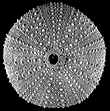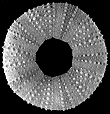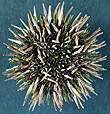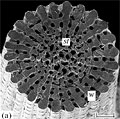The Echinoid Directory
Strongylocentrotus Brandt, 1835, p. 263
[=Euryechinus Verrill, 1866, p. 341 (objective); = Allocentrotus Mortensen, 1942, p. 232 (subjective), type-species Strongylocentrotus fragilis Jackson, 1912, by original designation; ? = Mesocentrotus Tatarenko & Poltaraus, 1993, p. 70, type species Strongylocentrotus franciscanus (Agassiz, 1863) by original designation. ]
| Diagnostic Features |
|
|---|---|
| Distribution | Early Miocene to Recent; Australia, North Pacific and North West Atlantic. |
| Name gender | masculine |
| Type | Echinus droebachiensis Muller, 1776, by original designation. |
| Species Included |
|
| Classification and/or Status |
|
| Remarks |
Resembles Paracentrotus in overall appearance but differs from that taxon in having the posterior ocular plates always broadly insert. The structure of the globiferous pedicellariae also immediately distinguishes these two, Paracentrotus having pedicellariae with an open blade, paired lateral teeth and no muscular neck. Distinguished from the very similar Mesocentrotus by its spines which are smaller and lack the large meshwork core seen in that genus Brandt, 1835 (May). Prodr. Descr. Anim. Rec. actes Acad. Imp. Sci. Petersburg [1834], p. 263.
|





